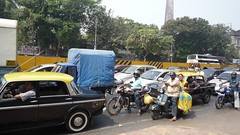Rules of the road: Ahmedabad vs Mumbai
Posted by Alex on 2 Nov, 2008 in Travel Bites | 1 comment
India 8: Indian driving styles
I’ve never seen traffic anything like the traffic in Ahmedabad. Not because it’s chaotic, but because they seem to have some set of unwritten rules that actually produce order from the chaos such that people rarely crash into one another. In Ahmedabad probably only a quarter of the vehicles are cars as we’d know them. Most are auto-rickshaws or motorbikes, and the rest are either tiny trucks shorter and narrower than Western cars, or a variety of thrown-together carts pulled by camel, cow, three-wheeled bicycle or even pulled by hand. There is no such thing as lane discipline. Since the average vehicle size is so much smaller, roads are typically filled four or five vehicles across. People cut into whatever gaps are available, bipping their horns as they do so to say “watch out, I’ve got this space”. I never heard anyone beeping out of frustration. The only rule I could discern is that like at sea, smaller vehicles give way to bigger vehicles.
The amazing thing is that there is no road rage to speak of, and while the vehicles seem to all look a little battered and dented, I only saw one bump the whole time we were there. The thing that stands out in my mind is that people seemed to just expect other people to cut them up, and accepted it graciously. I wondered what it would be like if we had such a system in the West – would there be fewer accidents? As we got out of the city I realised that one of the reasons it worked is that the traffic is fairly slow, so people have more time to react. Once you get out of the centre with vehicles at speed it gets a little more hairy. But still, it was very interesting to observe.
Mumbai, on the other hand was a completely different kettle of fish. Mumbai has quite possibly the worst traffic problem I’ve ever seen. In central Mumbai, auto-rickshaws are banned, as are cows (mostly), and most of the traffic consists of rich financial types being driven around in luxury saloon cars. The local cabs are smaller than the average car, old Fiat 1100s I’m told, but they look straight out of the 60s. There is very little chance to cut into gaps here, there are no gaps. Mumbai is gridlocked from 9 til 11 and 6 til 8 every day. Many Mumbai citizens have given up on road transport and take the train instead, meaning the trains are overcrowded with people hanging out of the open doorways. Many people become isolated to certain parts of the city because getting anywhere else in the city is just completely impractical – taxis and buses being affected just the same as private cars. Our hotel was only a couple of miles from our office, but it took almost an hour to get to and from work every day. We actually moved hotel to reduce our daily travelling time.
And there is road rage here. Boy, is there road rage. Every few seconds people are beeping and honking in frustration at the fact they just can’t get anywhere. In short, don’t ever expect to travel anywhere in Mumbai by road quickly. I expect it will completely grind to a halt within a couple of years if they don’t do something. The amount of businesses and hotels is continuing to grow, and there isn’t any more room on the road. If I were them I’d introduce a congestion charge, pronto!






Thanks for the article, Alex. I am 48, a proud Bombayite, and have lived in the U.S. for the last 18 years. However, still go to Mumbai/Bombay almost every year. That is where I “belong” but the exchange rate keeps me here!